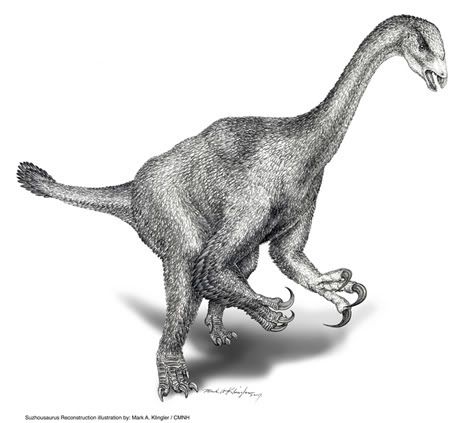"Strangest Dinosaurs Ever" Yield Clues to Dino GrowthJohn Roach
for National Geographic News

(An artist's rendering depicts Suzhousaurus megatherioides, a new species of dinosaur recently discovered in northwestern China.
The bizarre-looking animal belonged to a group of dinosaurs called therizinosaurs that lived in both Asia and North America. The newfound specimen suggests that the dinosaurs attained their large size in Asia long before their North American counterparts did.
Illustration by Mark A. Klingler, Carnegie Museum of Natural History)
October 5, 2007
An extraordinarily bizarre-looking species of dinosaur has been discovered in China's Gobi desert that could unlock clues as to how an unusual family of vegetarian dinos evolved, scientists say.
The newfound species belonged to a group of large dinosaurs called therizinosaurs, relatives of meat-eating theropods like Tyrannosaurus rex.
"These are without doubt some of the strangest dinosaurs ever found," said Matt Lamanna, a paleontologist at the Carnegie Museum of Natural History in Pittsburgh, Pennsylvania.
"They looked kind of like a gigantic plucked turkey."
The earliest known therizinosaurs date to 125 million years ago and have been found in eastern China and western North America.
Scientists are unsure where these dinosaurs evolved first, but they likely migrated between the continents on land bridges that periodically appeared millions of years ago.
The new specimen dates to about 115 million years ago and is the oldest large therizinosaur known.
The earliest large therizinosaur known from North America is Nothronychus, which dates to about 90 million years ago.
Named Suzhousaurus megatherioides, the new Gobi dino was about 22 feet (6.7 meters) long, 7 feet (2.1 meters) tall at the hips, and weighed between 1 and 2 tons.
The new fossil, discovered in 2002 but named only now, indicates that Asian therizinosaurs reached their large size before their North American counterparts did.
"It suggests that regardless of which continent they originated in, [therizinosaurs] got big in Asia before they got big in North America," Lamanna said.
(Read related story: "'Missing Link' Dinosaur Discovered in Montana" [October 2, 2007].)
Lamanna and his colleagues describe Suzhousaurus megatherioides , which means "giant sloth-like lizard from Suzhou," in the current issue of the Chinese journal Acta Geologica Sinica.
Adapted for Plants
Therizinosaurs had long necks, small heads, wide bodies, and unusually short tails. They also had large and powerful forelimbs that were tipped with three sharp claws, Lamanna said.
However, unlike most other theropods, which were meat-eaters, therizinosaurs were vegetarians.
"They've adapted to eating plants full time, and as a result their bodies became modified in very, very unusual ways compared to other theropods," Lamanna said.
He added that the claws were most likely used to fend off predators and may also have played a role in pulling tree branches toward their mouths, as in their namesake giant ground sloths.
Within ten million years of therizinosaurs' first appearance, they began to grow large, perhaps for protection or to better digest more plant food.
"We're not sure, but it does tell us that [this group] attained large size very rapidly after they first appeared," Lamanna said.
Lush Desert
The Gobi at the time of Suzhousaurus was more lush than it is today, noted study co-author Kenneth Lacovara, a geologist at Drexel University in Philadelphia.
Conifer and fern trees with underbrush of low-lying ferns likely filled a semi-arid landscape dotted with calm lakes that periodically dried up, according to his analysis of the sedimentary deposits.
Despite the periodic dry spells, Lacovara noted the environment contained enough vegetation to support the relatively large Suzhousaurus.
"In order to support a breeding population of animals that weigh as much as a sack of cows, you need an especially productive environment at the level of photosynthesis," he said.
"So it was obviously lush enough to keep these guys in business."
http://news.nationalgeographic.com/news/2007/10/071005-weird-dinosaur.html
 Win a FREE Membership!
Win a FREE Membership!